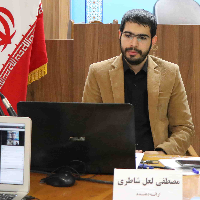Analyzing the relationship between visual narrative and fictional narrative in Noushafrin Gohartaj's lithographic book (1293 AH)
Statement Problem: folk literature has been the basis of visual presentation of narratives by illustrators for a long time. From the end of the Safavid period and the beginning of the Qajar period, this fortune and popularity increased, and the appearance of lithography, especially in illustrated form, was effective in spreading and publishing more and more of these stories. Among these cases, there is the story of the love between Nooshafrin and Prince Ibrahim. The origin of this prose folk tale is probably related to the Safavid period, but the author and the exact time of its composition are not known. However, its acceptability and popularity among the public has caused many copies of this story to exist in the form of manuscripts and lithographs. In this research, the characteristics and visual characteristics of 14 lithographic images without the name of the illustrator from the folk tale of Nooshafrin Gohartaj, version 1293 AH (stored in Astan Quds Razavi Library with registration number 41083) have been investigated. The purpose of the research: introducing and investigating the role of images in better expressing the meaning of the story and conveying it to the audience and how the image and the illustrated characters accompany the story line in the images of the 1293 edition of the story of Noush Afarin Gohartaj and subsequently examining the relationship between the illustrated characters and the text in the version It is based on the theory of text and image interaction. Research question: What is the relationship between the characters depicted in the story of Noush Afarin Gohartaj (lithographic version published in 1293 AH) with the trajectory of the narrative and what features are used in the said depictions, and in the meantime, the relationship between text and image based on the theory of interaction between text and image How is Marianikolaeva and Carol Scott? Research
The nature of the fundamental research is based on a quantitative approach, based on the descriptive-analytical research method, based on the theory of the interaction of text and image by Maria Nikolayeva and Carol Scott, and based on the direct observation of the manuscript and relying on library sources.
The narrative illustrations of the researched version have the characteristics of traditional Iranian painting, as well as the characteristics of Qajar paintings and the style of court portrait painting of this period, which was influenced by Western art. The images are absolutely at the service of the text and relatively moved along with the text and progressed with the relative or complementary relationship with the text, and of course, knowingly or unknowingly, there is a place left for the imagination of the audience to fantasize and role play. Key words: Narrative illustration, Lithography, Folk tales, Noushafrin Gohartaj, Text and image interaction theorycharacteristics of traditional Iranian painting, as well as the characteristics of Qajar paintings and the style of court portrait painting of this period, which was influenced by Western art. The images are absolutely at the service of the text and relatively moved along with the text and progressed with the relative or complementary relationship with the text, and of course, knowingly or unknowingly, there is a place left for the imagination of the audience to fantasize and role play. Key words: Narrative illustration, Lithography, Folk tales, Noushafrin Gohartaj, Text and image interaction theorynarratives by illustrators for a long time. From the end of the Safavid period and the beginning of the Qajar period, this fortune and popularity increased, and the appearance of lithography, especially in illustrated form, was effective in spreading and publishing more and more of these stories. Among these cases, there is the story of the love between Nooshafrin and Prince Ibrahim. The origin of this prose folk tale is probably related to the Safavid period, but the author and the exact time of its composition are not known. However, its acceptability and popularity among the public has caused many copies of this story to exist in the form of manuscripts and lithographs. In this research, the characteristics and visual characteristics of 14 lithographic images without the name of the illustrator from the folk tale of Nooshafrin Gohartaj, version 1293 AH (stored in Astan Quds Razavi Library with registration number 41083) have been investigated. The purpose of the research: introducing and investigating the role of images in better expressing the meaning of the story and conveying it to the audience and how the image and the illustrated characters accompany the story line in the images of the 1293 edition of the story of Noush Afarin Gohartaj and subsequently examining the relationship between the illustrated characters and the text in the version It is based on the theory of text and image interaction. Research question: What is the relationship between the characters depicted in the story of Noush Afarin Gohartaj (lithographic version published in 1293 AH) with the trajectory of the narrative and what features are used in the said depictions, and in the meantime, the relationship between text and image based on the theory of interaction between text and image How is Marianikolaeva and Carol Scott? Research
The nature of the fundamental research is based on a quantitative approach, based on the descriptive-analytical research method, based on the theory of the interaction of text and image by Maria Nikolayeva and Carol Scott, and based on the direct observation of the manuscript and relying on library sources.
-
An analysis on illustrations of Dale Mukhtar lithographic book based on formative criticism (Case study: the version 1330 AH)
Seyede Sepide Mojtahedi *, Mostafa La&Rsquo, L Shateri
Ferdows Honar, -
Perspective in Seyyed al-Shaara's lithographic works (case study: illustrations of Bahr al-Fawaed book)
Zohreh Sarabi, Mostafa La’L Shateri *
Ferdows Honar,



